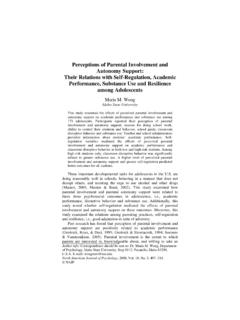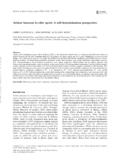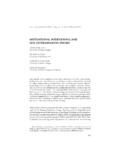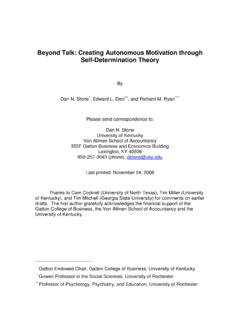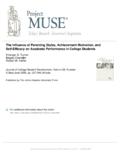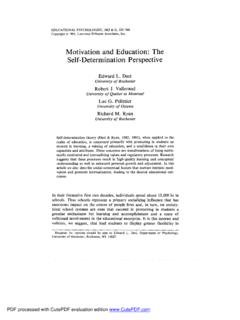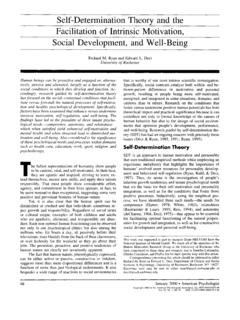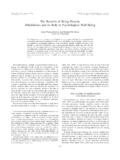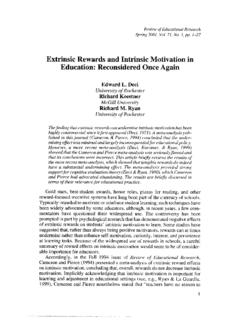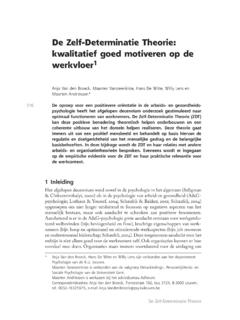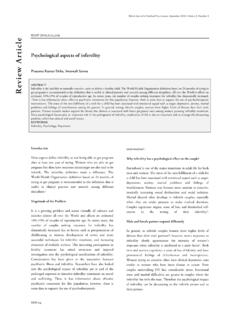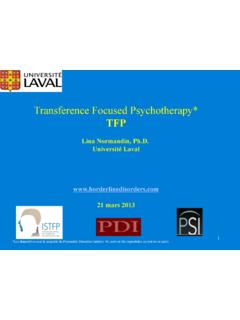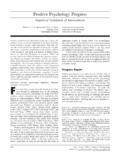Transcription of EHP March 2008 draft4 - Self-Determination Theory
1 Richard M. Ryan*1, Heather Patrick1, Edward L. Deci1, and Geoffrey C. Williams1 1 University of Rochester, USA original article Facilitating health behaviour change and its maintenance: Interventions based on Self-Determination Theory Despite many recent technical breakthroughs in health care, human behaviour remains the largest source of variance in health-related outcomes (Schroeder, 2007).
2 People s health and well-being are robustly affected by lifestyle factors such as smoking, hygiene, diet, and physical activity, all of which involve behaviours that are potentially controllable by the individual. In addition, outside of acute care settings, the effectiveness of most health care interventions is highly dependent on the patient s adherence to self -care activities such as taking medications, performing self -examinations, or refraining from specific activities or habits.
3 A significant problem is the poor adherence to prescribed changes or recommended behaviours over time. In the perspective of Self-Determination Theory (SDT: Deci & Ryan, 2000; Ryan & Deci, 2000), recognition of these behavioural mediators of health outcomes suggests that we attend more carefully to the patient s experience and motivation. According to SDT, maintenance of behaviours over time requires that patients internalize values and skills for change, and experience Self-Determination .
4 The Theory further argues that by maximizing the patient s experience of autonomy, competence, and relatedness in health-cares settings, the regulation of health-related behaviours is more likely to be internalized, and behaviour change will be better maintained (Williams, Deci, & Ryan, 1998). As a general Theory of motivation, SDT has spawned experimental and field studies of how factors such as rewards, sanctions, use of authority, provision of choice, and level of challenge impact patients experiences, and in turn their behavioural persistence and outcomes (Deci & Ryan, 2000).
5 Over the past 15 years a growing body of work has applied SDT in studies of health-related behavior change (Patrick, Williams, Fortier et al., 2007; Ryan & Deci, 2007; Williams et al., 1998). Such work has examined how factors in treatment environments associated with patients autonomy, competence, and relatedness, affect both the initiation and maintenance of change. More recently a number of controlled clinical trials have tested the efficacy of SDT-framed interventions for issues as diverse as tobacco dependence, diet, physical activity, and dental care.
6 Our aim in this brief paper is to explicate the SDT model of health behaviour change and provide a partial review of its empirical support and limitations. Self-Determination Theory Health researchers ( , Rothman, 2000) have described the process of health behaviour change as entailing the dual tasks of initiating and maintaining change. Although there are many approaches to initiating change, from external pressure and control to the positive use of incentives or rewards, the ingredients essential to maintenance are often missing.
7 SDT, in contrast, is particularly focused on the processes through which a person acquires the motivation for initiating new health-related behaviours and maintaining them over time. SDT argues that developing a sense of autonomy and competence are critical to the processes of internalization and integration, through which a person comes to self -regulate and sustain behaviours conducive to health and well being. Thus, treatment environments that afford autonomy and *Corresponding Author: Richard Ryan; email: Richard Ryan Professor of Psychology, Psychiatry, & Education Department of Clinical & Social Psychology University of Rochester Rochester, USA support confidence are likely to enhance adherence and health outcomes.
8 Equally important to internalization in the SDT view is a sense of relatedness. People are more likely to adopt values and behaviours promoted by those to whom they feel connected and in whom they trust. Autonomy. Most health-related behaviours, such as increasing physical activity, taking medications, or quitting smoking, are not intrinsically motivated or inherently enjoyable activities. Thus, if such behaviours are to be successfully enacted and maintained outside of treatment settings or controlled environments, individuals must come to value the behaviours and personally endorse their importance.
9 Unfortunately, many people engage in behaviour changes only because of what in SDT is labelled controlled motivation. One common form of controlled motivation is external regulation, in which a person acts only to get an external reward, avoid a punishment or to comply with social pressures. Practitioners often create external regulation by suggesting incentives or contingencies, or by trying to motivate through mere authority. Another form of controlled motivation is introjection, in which a patient might act to receive approval or praise, or to avoid disapproval or feelings of guilt.
10 Introjection is often cultivated by practitioners as a way of goading patients into action by conveying contingent approval. According to SDT, both forms of controlled regulation, external and introjected regulation, are largely unrelated to long term adherence. In contrast change can be a function of autonomous motivation. One form of autonomous motivation is identified regulation, in evidence when one personally endorses or identifies with the value or importance of a behaviour or health practice.
